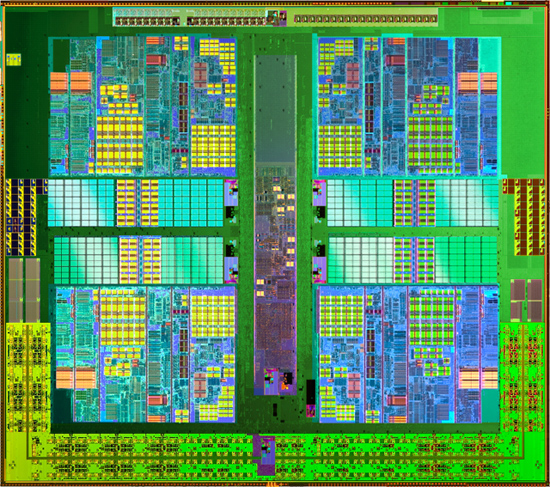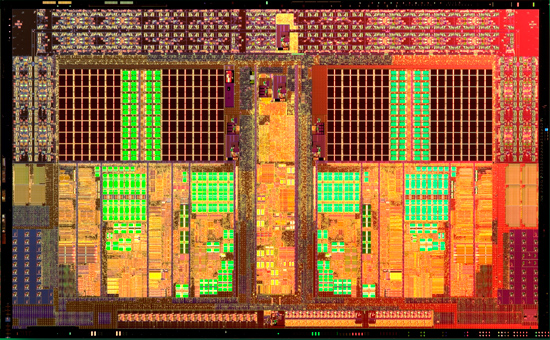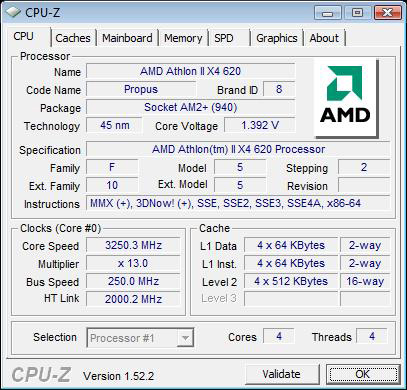AMD Athlon II X4 620 & 630: The First $99 Quad Core CPU
by Anand Lal Shimpi on September 16, 2009 12:00 AM EST- Posted in
- CPUs
How does AMD respond to Lynnfield? Is it by drastically cutting prices on Phenom II? Nope. By introducing the world’s first quad-core processor to debut at $99. Now that’s cool.

It’s called the Athlon II X4 and its existence shouldn’t be any surprise. AMD quietly announced it along with the Athlon II X2 line.

Today we get two models: the Athlon II X4 630 and the Athlon II X4 620, priced at $122 and $99 respectively. The only difference between the two is clock speed; the 630 runs at 2.8GHz while the 620 runs at 2.6GHz. These are both AM3 chips meaning they'll work in AM3 motherboards with DDR3 memory or AM2+ boards with DDR2 memory.
| Processor | Clock Speed | L2 Cache | L3 Cache | TDP | Price |
| AMD Phenom II X4 965 BE | 3.4GHz | 2MB | 6MB | 140W | $245 |
| AMD Phenom II X4 955 BE | 3.2GHz | 2MB | 6MB | 125W | $245 |
| AMD Phenom II X4 945 | 3.0GHz | 2MB | 6MB | 125W | $225 |
| AMD Phenom II X3 720 BE | 2.8GHz | 1.5MB | 6MB | 95W | $145 |
| AMD Phenom II X2 550 BE | 3.1GHz | 1MB | 6MB | 80W | $105 |
| AMD Athlon II X4 630 | 2.8GHz | 2MB | 0MB | 95W | $122 |
| AMD Athlon II X4 620 | 2.6GHz | 2MB | 0MB | 95W | $99 |
| AMD Athlon II X2 250 | 3.0GHz | 2MB | 0MB | 65W | $87 |

This isn’t a harvested Phenom II nor is it a pair of Athlon II X2s, instead it looks like we have a brand new die on our hands (some Athlon II X4s will be crippled Phenom IIs but AMD insists that the new die will be used). The Athlon II X4 has four cores on a single die, but unlike the Athlon II X2 each core only has a 512KB L2 per core. You can tell by the die shot that the core-to-cache ratio is much higher than on the X2:

The 45nm Athlon II X4 Propus die

The 45nm Athlon II X2 die (note the larger L2 per core)
Like the rest of the Athlon II lineup there is no L3 cache. This helps keep the die small (and affordable) but also hurts performance:
| Processor | SYSMark 2007 Overall | E-Learning | Video Creation | Productivity | 3D |
| AMD Phenom II X4 920 (2.8GHz) | 173 | 151 | 212 | 167 | 167 |
| AMD Athlon II X4 630 (2.8GHz) | 157 | 128 | 221 | 131 | 162 |
| % of Phenom II X4 | 91% | 85% | 104% | 78% | 97% |
At the same clock speed the Athlon II X4 should offer roughly 90% of the performance of a Phenom II X4.
| Processor | Cores | Manufacturing Process | L1 Cache | L2 Cache | L3 Cache | Die Size | Transistor Count |
| AMD Phenom II X4 | 4 | 45nm | 128KB per core | 512KB per core | 6MB | 258 mm2 | 758M |
| AMD Athlon II X4 | 4 | 45nm | 128KB per core | 512KB per core | 0MB | 169 mm2 | 300M |
| AMD Athlon II X2 | 2 | 45nm | 128KB per core | 1MB per core | 0MB | 117 mm2 | 234M |
| Intel Core 2 Quad Q8xxx | 4 | 45nm | 64KB per core | 4MB | 0MB | 164 mm2 | 456M |
The price is unbeatable. If we ignore the 630 for a moment, the Athlon II X4 620 is by far the cheapest route to four cores on the market. Intel’s most affordable quad-core is the Core 2 Quad Q8200 at $163, while AMD would previously charge you $163 for a Phenom X4 9600B. This is where the AM3/AM2+ compatibility play really helps out. Motherboard/memory costs are as cheap as possible thanks to AMD's incredible socket flexibility.

And just in case you’re wondering, yes, the Athlon II X4 620 actually delivers performance competitive with the Q8200 but for 60% of the cost. It’s not all that clear cut, there are some cases where the 620 is faster but others where the Q8200 is much faster. On average it ends up being a wash but you’ll want to pay attention to the coming pages to see how the cookie crumbles as it does vary from test to test.

Codename Propus
Overclocking isn't unfortunately as good as the Phenom IIs; the result of a conscious design decision or simply the early nature of the Propus die. That being said, without a single extra millivolt I was able to hit 3.25GHz on my Athlon II X4 620 sample - making it even more valuable. Extra voltage proved mostly useless, I could only approach 3.4GHz with an extra 300mV.
Let’s see, have I thoroughly ruined the surprise? Check. Now let’s get to the tests.
The Test
| Motherboard: | Intel DX58SO (Intel X58) Intel DX48BT2 (Intel X48) Gigabyte GA-MA790FX-UD5P (AMD 790FX) |
| Chipset: | Intel X48 Intel X58 AMD 790FX |
| Chipset Drivers: | Intel 9.1.1.1015 (Intel) AMD Catalyst 8.12 |
| Hard Disk: | Intel X25-M SSD (80GB) |
| Memory: | Qimonda DDR3-1066 4 x 1GB (7-7-7-20) Corsair DDR3-1333 4 x 1GB (7-7-7-20) Patriot Viper DDR3-1333 2 x 2GB (7-7-7-20) |
| Video Card: | eVGA GeForce GTX 280 |
| Video Drivers: | NVIDIA ForceWare 180.43 (Vista64) NVIDIA ForceWare 178.24 (Vista32) |
| Desktop Resolution: | 1920 x 1200 |
| OS: | Windows Vista Ultimate 32-bit (for SYSMark) Windows Vista Ultimate 64-bit |










150 Comments
View All Comments
Chlorus - Wednesday, September 16, 2009 - link
He posted right after me...I'm kinda wondering if we should setup a drinking game or something each time he posts.strikeback03 - Wednesday, September 16, 2009 - link
Good idea, and everyone drinks when you spot a new alias.deputc26 - Wednesday, September 16, 2009 - link
I would absolutely love to see a die size comparison. That will give real information on how this chip can make AMD $$.Lokinhow - Wednesday, September 16, 2009 - link
there is a die size comparsion on the first page..P2 X4 = 258 mm2
A2 X4 = 169 mm2
A2 X2 = 117 mm2
C2Q 8xxx = 164 mm2
deputc26 - Wednesday, September 16, 2009 - link
Apparently I'm a moron. Don't know how I missed that unless it was added after initial publication as I read it right after it came out.Eeqmcsq - Wednesday, September 16, 2009 - link
Anand, how did you know whether or not your Athlon II X4s are harvested Denebs?Also, any idea why the Athon II X4s debut at such a high TDP with no L3? I'd think they'd be lower at 65w or at least 80w.
AMD, $100 quad cores is nice... BUT... where's the 45w quads???
Lokinhow - Wednesday, September 16, 2009 - link
I may be wrong, but..I think the high TDP is because we have both Propus and Deneb-Harvested Cores
The Athlon II based on Deneb probably have this 95W TDP, while the ones based on propus core have lower TDP.
I think they have only a few propus core to sell, so that's why they are selling harvesteds Denebs. When there wil have only Athlons II X4 propous based they'll rate it with a lower TDP.
Makes sense?
Spoelie - Wednesday, September 16, 2009 - link
Yes and noIt's a bit strange that the deneb die (630) consumes less power than the propus die (620) in idle if that theory was valid. During load the difference is just as much as the difference in clock speed would indicate. So if the 630 is indeed a deneb (care to rip the IHS of? ;)) then this means that propus is not by definition less power hungry than deneb.
Anand Lal Shimpi - Wednesday, September 16, 2009 - link
AMD specifically told us that our 620s are Propus samples, but that others may be Denebs. I'm not sure how to tell if you have a harvested Deneb just yet.Give AMD some time, I'm sure we'll see them down below 95W as the process matures for these dice.
Take care,
Anand
TA152H - Wednesday, September 16, 2009 - link
Anand,A couple of things. You mentioned the 'small' L2 cache being a problem on one of your benchmarks, but, it's actually twice as large as the one on the Phenom. I'm not sure if this was meant to be a comparison only with the Penryns, but it's a bit confusing.
Also, going back to the L2 cache, how can these possibly be harvested from Phenoms with a bad L3 cache. That would imply the Phenoms are built with 512K L2 cache, with half of it disabled. I really doubt this is the case. You CAN remove the L3, but how do they then double the L2 cache? This seems strange to me.
Based on the relatively poor overclocking potential of this chip, would you attribute that to the L2 cache? Does the L2 cache run with the same number of wait states as that of the Phenom? If so, that could prove to be the main reason for the lower overclocking potential. Any ideas on this?
Also, don't you think it's worth mentioning AMD's greatly superior IGPs, considering this product could easily find it's way in this platform rather often. The processor by itself does make sense, but, even if it didn't, the superior IGP platform still can make AMD processors somewhat attractive.